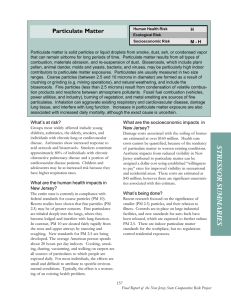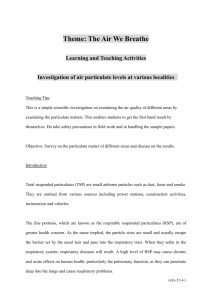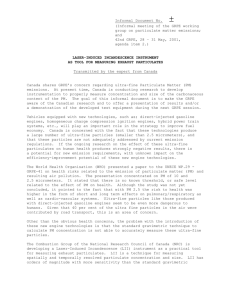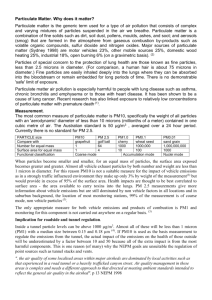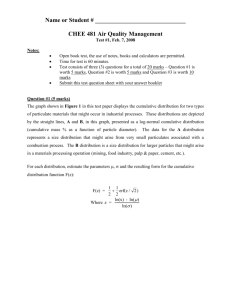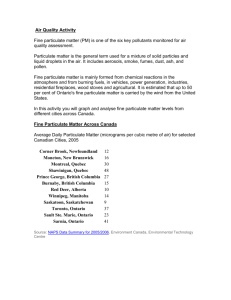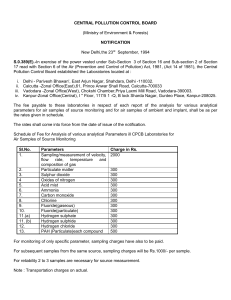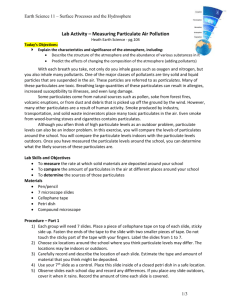Airborne Particulate Lab
advertisement
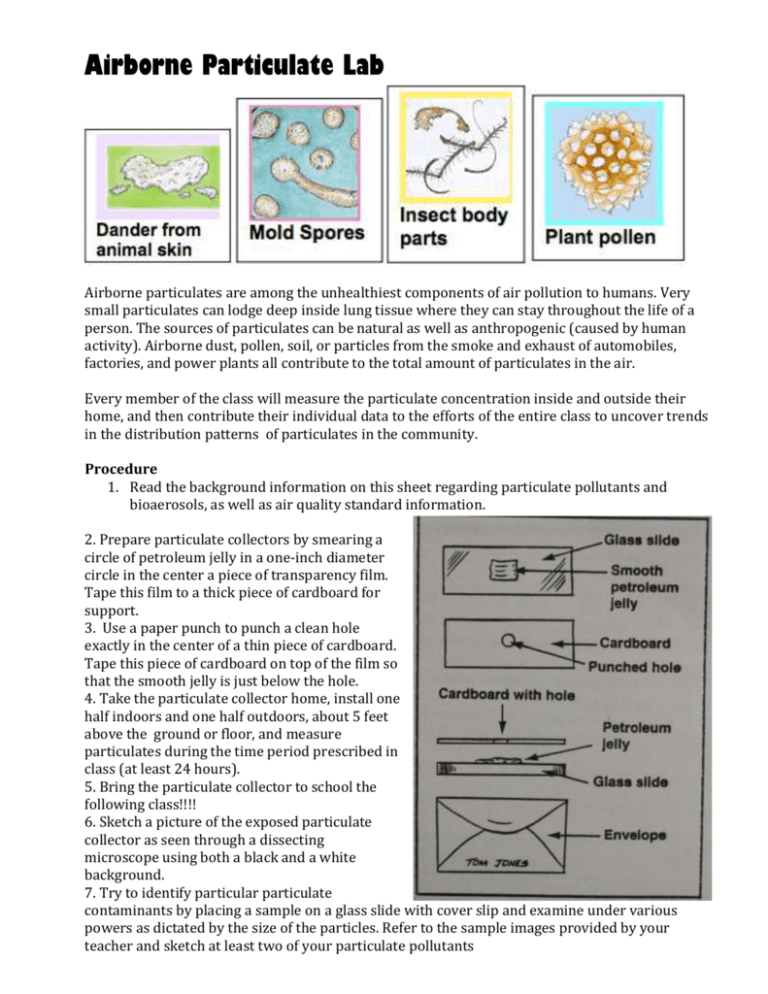
Airborne Particulate Lab Airborne particulates are among the unhealthiest components of air pollution to humans. Very small particulates can lodge deep inside lung tissue where they can stay throughout the life of a person. The sources of particulates can be natural as well as anthropogenic (caused by human activity). Airborne dust, pollen, soil, or particles from the smoke and exhaust of automobiles, factories, and power plants all contribute to the total amount of particulates in the air. Every member of the class will measure the particulate concentration inside and outside their home, and then contribute their individual data to the efforts of the entire class to uncover trends in the distribution patterns of particulates in the community. Procedure 1. Read the background information on this sheet regarding particulate pollutants and bioaerosols, as well as air quality standard information. 2. Prepare particulate collectors by smearing a circle of petroleum jelly in a one-inch diameter circle in the center a piece of transparency film. Tape this film to a thick piece of cardboard for support. 3. Use a paper punch to punch a clean hole exactly in the center of a thin piece of cardboard. Tape this piece of cardboard on top of the film so that the smooth jelly is just below the hole. 4. Take the particulate collector home, install one half indoors and one half outdoors, about 5 feet above the ground or floor, and measure particulates during the time period prescribed in class (at least 24 hours). 5. Bring the particulate collector to school the following class!!!! 6. Sketch a picture of the exposed particulate collector as seen through a dissecting microscope using both a black and a white background. 7. Try to identify particular particulate contaminants by placing a sample on a glass slide with cover slip and examine under various powers as dictated by the size of the particles. Refer to the sample images provided by your teacher and sketch at least two of your particulate pollutants Fast Facts (From http://www.epa.gov/air/particlepollution/fastfacts.html) • Particles that are less than 2.5 micrometers in diameter are known as "fine" particles; those larger than 2.5 micrometers, but less than 10 micrometers, are known as "coarse" particles. • Fine particles are easily inhaled deep into the lungs where they may accumulate, react, be cleared or absorbed. • Studies estimate that thousands of elderly people die prematurely each year from exposure to fine particles. • Scientific studies have linked particle pollution, especially fine particles, with a series of significant health problems, including: increased respiratory symptoms, such as irritation of the airways, coughing, or difficulty breathing decreased lung function; aggravated asthma; development of chronic bronchitis; irregular heartbeat; nonfatal heart attacks; and premature death in people with heart or lung disease. • Fine particles can remain suspended in the air and travel long distances. For example, a puff of exhaust from a diesel truck in Los Angeles can end up over the Grand Canyon. • The average adult breathes 3,000 gallons of air per day. • According to the American Academy of Pediatrics, children and infants are among the most susceptible to many air pollutants. Children have increased exposure compared with adults because of higher minute ventilation and higher levels of physical activity. • Particle pollution, unlike ozone, can occur year-round. What is Particulate Matter? Particulate matter -- particulates or PM for short -- refers to the many types and sizes of particles suspended in the air we breathe each day. Particulates include products of combustion, such as soot or ashes, wind blown dust, and minute droplets of liquids known as aerosols. PM can range in size from visible pieces of sand and dirt to microscopic particles so small that 500,000 of them could fit on the period at the end of this sentence. Why should you be concerned about PM? Particulate matter not only impairs visibility, it also poses a serious health threat to citizens. Our respiratory systems are equipped to filter out larger particles. However, the lungs are vulnerable to particles less than 10 microns in diameter (PM10), which can slip past the respiratory system's natural defenses. Very tiny particles (PM2.5) can penetrate deeply into the lungs and do the most harm. The particulates we breathe enter the lungs and pass through progressively smaller airways until they reach the alveoli, tiny air sacs where oxygen enters the blood stream. Particulates that get trapped in these most sensitive tissues interfere with oxygen uptake. Toxic and cancer-causing compounds can "hitchhike" into the lung on these particulates and be directly absorbed into the lungs. Where does particulate matter (PM) come from? PM is introduced to the air through both natural and anthropogenic (manmade) causes. The primary sources of PM include agricultural dust, motor vehicles; diesel trucks and buses residential wood stoves and fireplaces industrial emissions agricultural, slash and yard waste burning exhaust from lawn mowers and boats. PM concentrations tend to be especially high in area with greater population density, nearby industries or agriculture, or where local topography or weather conditions contribute to air stagnation. What is being done to control PM air pollution? Our nation's Clean Air Act of 1970, in combination with important amendments adopted in 1977 and 1990, requires that the United States Environmental Protection Agency (EPA) identify and set standards for air pollutants. These National Ambient Air Quality Standards (NAAQS) must be strict enough to protect the health of even the most sensitive members of the population. PM10 is currently one of six "criteria" pollutants identified by the EPA. Here in California, the Department of Ecology and local air pollution control agencies cooperate with the EPA to implement laws designed to reduce PM levels. From:http://www.ces.ncsu.edu/depts/fcs/housing/pubs/fcs3605.html What are bioaerosols? Bioaerosols are extremely small living organisms or fragments of living things suspended in the air. Dust mites, molds, fungi, spores, pollen, bacteria, viruses, amoebas, fragments of plant materials, and human and pet dander (skin which has been shed) are some examples. They cannot be seen without a magnifying glass or microscope. Can bioaerosols cause health problems? They can cause severe health problems. Some, like viruses and bacteria, cause infections (like a cold or pneumonia). Others cause allergies. Both allergic responses and infections may be serious or even fatal. Rashes, hay fever, asthma (tightness in the chest, difficulty in breathing), and runny noses are common allergic reactions. A few people develop a severe allergic reaction in the lung, which can destroy lung tissue. This is called hypersensitivity pneumonitis. It is not an infection, but repeated episodes can lead to infections of the lung, such as bacterial pneumonia. Hypersensitivity pneumonitis can be triggered by exposure to very small amounts of the allergen, once a person is sensitive to it. Symptoms can range from tightness in the chest, cough, and difficulty in breathing, to low-grade fever, muscle aches, and headaches. What are sources of bioaerosols in the home? Molds, mildews, bacteria, and dust mites like the same conditions that we do--warmth and moderate to high humidity. They need little more than a constant moisture supply for survival. You may find bacteria, molds, and mildews in air conditioning equipment, humidifier reservoirs, dehumidifier drip pans, showerheads, toilets, and ice machines. Water damaged carpets, ceiling panels, walls, and paneling are prime sites for new growth if they are allowed to stay damp. When molds, mildew, dust mites, and bacteria are disrupted or release their spores into the air, this results in bioaerosol formation. Data: Name____________________________________ Look at your particulate collectors with both a black and white background. Sketches: Indoor collector magnification _________ Outdoor collector magnification _________ Zoom of one particulate on indoor collector Zoom of one particulate on indoor collector Type ______________________magnification ________ Type _____________________magnification________ Conclusion Questions 1. What is the difference between a “fine” vs. “course” particulate pollutant? 2. List three health effects caused by particulates? 3. Name four examples of particulate pollutants. 4. Name four specific sources of particulates and identify them as natural or anthropogenic. 5. Which agencies regulate particulate pollution? 6. What are bioaerosols? 7. What are some of the symptoms associated with bioaersol hypersensitivity? 8. Which pollutants surprised you in terms their high or low levels? Why? 9. What kind of specific measures could you take to specifically reduce indoor particulate pollutants? 10. What were the likely sources of the particulates identified in your indoor samples? Explain!
